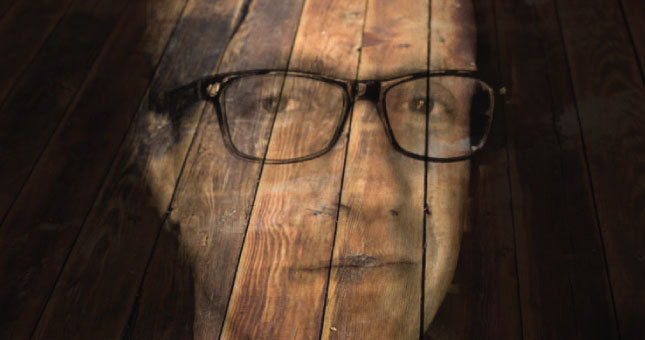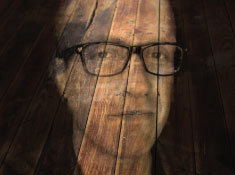
Summertime Blues
Kurt Armstrong (MA '07) lives in Winnipeg, Manitoba with his wife, Erika, and their three kids. He is a lay minister at Saint Margaret's Anglican Church and a home renovator. He has written for Image, The Globe and Mail, and Geez, and is the author of Why Love Will Always Be A Poor Investment (Wipf & Stock).
I’ve done more work at 485 Kingsway than at any other house in the city. David and Ruth, priest and liturgist at my little Anglican church in Winnipeg, live in a beautiful, century-old home in River Heights, just ten blocks away on the other side of the river from my home. In the six years since I started doing handyman work, they’ve hired me to prop up their collapsing back fence, hang blinds, replace an entry door, repair the plumbing for the outside tap (twice), build book-and-CD-shelves, fix a broken eavestrough, and replace the screens on the second-floor porch. They called me once to see if I could dig a nailclipper out of the drain where someone had dropped it fifteen years ago. When I went to disconnect the drain, the sink was so rusted it snapped. There was no replacement sink to fit the vanity, which meant a new tap, new sink, new vanity, different footprint on the lino, and patchy finish on the drywall. I started digging nail clippers out of a drain and ended up redoing the entire bathroom. Renominoes. A year after that I renovated the upstairs bathroom, and then the one on the main floor.
A couple of Augusts ago they asked me to re-finish the floors on their third floor. Their house, like plenty of others in central Winnipeg from the same era, had the more durable oak on the main floor, and the less expensive fir on the higher floors. Fir is technically a softwood, a term which refers to the type of tree—gymnosperm, or coniferous. But fir isn’t soft, especially old-growth Douglas fir that’s been air-drying for 100 years. I’ve worked with fir joists so strong I had to pre-drill nail holes to keep the 3-inch spikes from bending. When fir flooring wears, the long, straight grain starts to splinter, and a snag on your socks can pull up a sliver 12 inches long.
The top floor had two rooms: a guest room and a mostly empty room with a wide open floor where the two of them practiced Latin and ballroom dancing. The floors had carpet-glue stains and scattered patches that had been painted and then half scraped and sanded. I took everything out of the rooms and hauled it downstairs, hauled my bags of supplies and tools up, and sealed off the top of the staircase with curtains of plastic and wide masking tape.
I took off some of the thickest layers of old paint with a sharp paint scraper and rented a square-buff sander. The sander looked like an enormous vacuum cleaner and it weighed more than 120 pounds. I bought stacks of sanding sheets, starting with 36-grit but getting finer and finer, and sanded away the old, uneven layers of glossy varnish. The sander rumbled and shook the house like a noisy little earthquake, the heavy, growling, vibrating machine floating like a shiny hovercraft with a cord. For two days I walked it slowly back and forth across the rooms in sweeping patterns, my hands slowly turning numb from the vibration. As I moved to the finer grit sandpaper, the red dust grew finer as well, caking my sweaty arms and face. Before going home each day, I’d pat my clothes and look like Pigpen with his shadow cloud of grime. I sanded the floors down to bare, pale-orange wood, the long grain of the boards as clear as thin lines traced with a hard pencil. When the sanding was finished, I brushed the dust off the walls and baseboards, swept four times, vacuumed the floor and all the gaps and cracks, and wiped down every square inch with a sticky tack cloth until the floor was spotless.
Wood is a magnificent substance: its sound, smell, feel, and especially its look. Wood grain is like subtle, natural, abstract art. I’m not confident enough to shell out the cash for expensive woods with beautiful names—purpleheart or bubinga or wenge or lacewood— but even something common like birch has undulating, sensuous curves in the grain, layers and lines and tones, swirls and whorls of growth that can bend and twist light like a hologram. Even a straight-grained wood like fir can refract light differently from different angles.
I know an ambitious, energetic builder who loves the look and feel of unfinished wood. Whenever he installs hardwood in a home he encourages his customers not to varnish the floor because, he tells them, it’s putting a layer of plastic between their feet and that beautiful, natural, real wood. If I ever have enough money to re-do the floors in my own house I’m going to follow his advice. But an unfinished fir dance floor seemed certain to splinter and suffer under the footfalls of the waltz, shuffle, and bossanova, so I bought four gallons of clear, satin varnish, enough for three coats.
From the very first brushstroke, I knew it was all wrong. Even though it was a water-based varnish, it turned the raw, pale wood deep orange. All of the subtle, gentle lines of the grain turned dark like burn marks. I’d ruined it. Hours of planning, hauling, preparing, scraping, sanding, and cleaning: poof. Wrecked. All for nothing. It looked nothing like the clean, pure wood I’d worked so hard to expose. It looked like old wood.
I never know how to see my own work clearly—maybe no one does. In August, though, any work I do is complicated by thinking muddied by depression. My deepest depressive cycles follow a fairly simple pattern: one in early winter and another in late summer. I start to slip into the murk, spend a couple of dark weeks beneath the waves, then gradually climb back into the light. I’m a high-functioning depressive: I’ve always been able to get a lot done, even when I’m at my lowest. I’m grateful I’m not laid right out by my depressive spells, though sometimes I think two weeks in the psych-ward would be easier than pushing through the day-to-day with all the light and joy drowned in blackness.
The worst part of my low is the relentless mental monologue. It’s nothing audible; more like the normal self-conscious thoughts most of us experience now and then except uninterrupted and fiercely self-loathing. The voice says “You’re stupid and useless. You’re a waste. You’re a black hole. You’re a piece of garbage, and nobody wants to be around garbage. Toss it and it’s gone.” On and on it goes, day after day for weeks, starting the moment I open my eyes in the morning until I collapse into sleep at night, an endless, monotonous commentary on my day, a narrative of self-hatred. Stupid and useless, not smart enough to really figure anything out, and incapable of doing what actually needs to be done.
I’ve personified my self-loathing voice, and it’s not a raging, snarling demon with fangs and claws, or an evil, faceless ghoul. It’s a fat, middle-aged, balding man who needs a shower and shave. He wears a greasy ball cap, a stained hockey jersey, crisp blue jeans, and a worn leather jacket, and he smells like cigarettes and mouthwash and stale sweat. He curls his lip in a sneer and watches over my shoulder. “Why didn’t you wake up earlier today? Why are you so needy? Why are you wasting your time? Wasting time: that’s what you do best. You’ve wasted all those years in school and now you’re wrecking your life and your family. You’re a waster, a wrecker, a destroyer, you piece of garbage. You’re wrecking your family. You’re stupid and you’re useless. No, you’re worse than useless. You’re a waste. The world would be better off if you weren’t around.”
As I brushed coats of varnish on the fresh boards, I rehearsed various offers to the customers: I’ll bill for the materials and tool rental, but I’ll eat the labour costs; or I’ll eat the cost of the varnish and the sanding work, but I won’t pay to re-do my mistake; or I’ll bill as planned, then hire someone to re-do it at my expense.
I’d already taken on enough handyman jobs to know better than to air my self-indulgent insecurities in front of the people I’m working for. I don’t like groveling messes either, and though I’ve spent much of my life apologizing for simply being myself, I’ve learned how to act like a grownup, even though I stalled out emotionally around twelve years old. I decided I’d eat the cost of the whole thing, and apologize for wasting their time, but only after they’d seen it. When the final coat of varnish was dry, I summoned them to the top floor to survey the results.
I lifted the plastic curtain I’d taped up, and before I even led them into the first room, both of them were already murmuring their satisfaction. Ruth was the first to speak. “Oh, it’s fabulous,” she said, “just fabulous. It’s exactly what I’d hoped for. No, actually I didn’t even think the colour would be this rich. It’s gorgeous. I love it.” David smiled and nodded his approval. I showed them tricky spots where old paint lines had been especially stubborn and had gummed-up the sanding sheets, how I’d worked right into the closets as best I could, how the different wall colours in the two rooms changed the tone of the finished wood in each room. “You take better care of our house than we do,” said David. “I love it,” Ruth repeated. “Won’t it be lovely to dance in here?”
They went back downstairs and I packed up my cases of tools and gathered the last bits of garbage. Before I hauled everything downstairs and out to the van, I stopped and sat and slumped on the floor and wept until my jaw ached and my eyes were red and puffy.
I wrote up an invoice that night and emailed it to them, and they had a cheque for me at church on Sunday morning.


